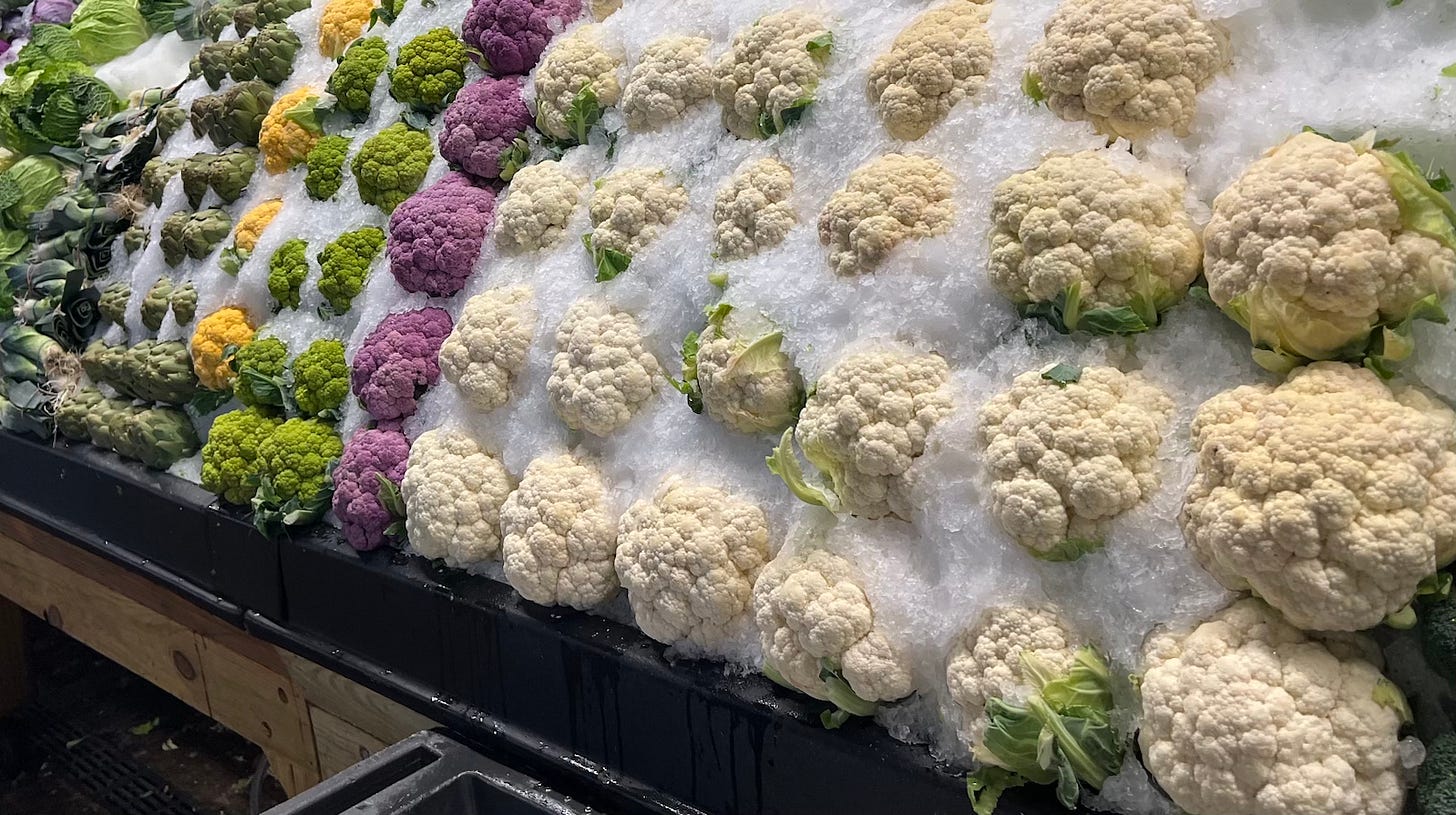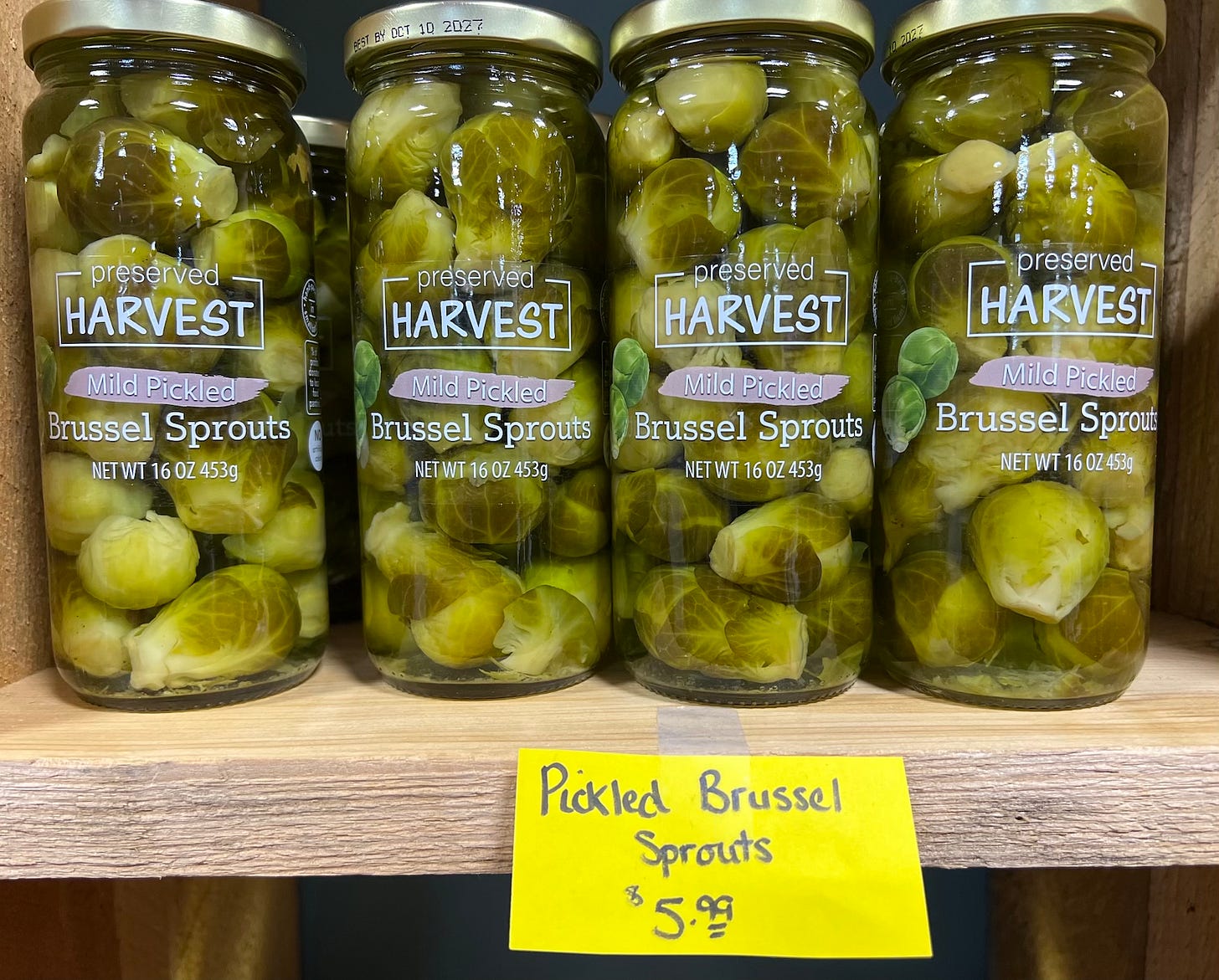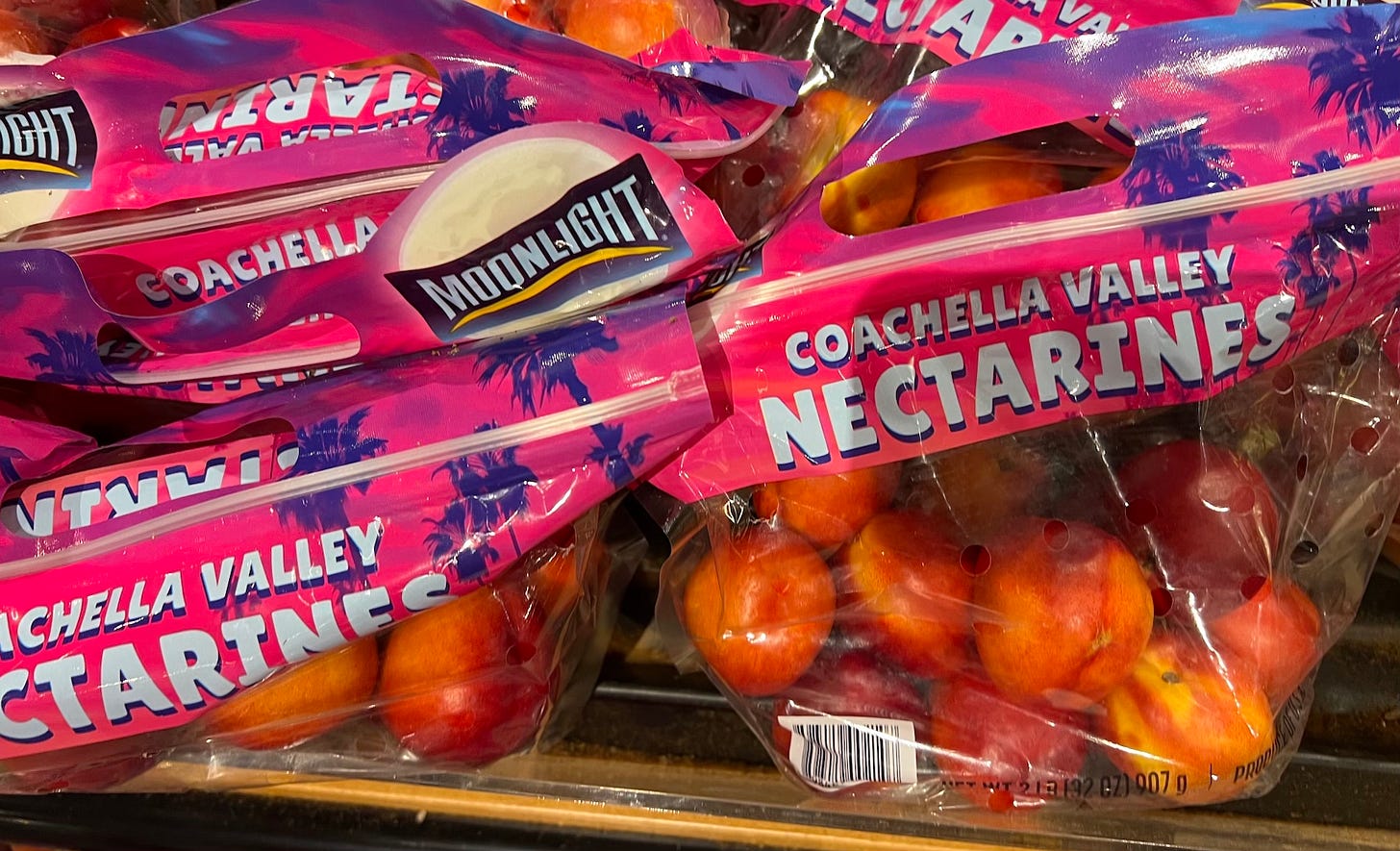Grocery Update Volume 2, #5: Cold Chain Manifesto.
Also: How To Stop Weakened H-2A Provisions and Protect Farmworkers.
Discontents: 1. Stop Weakened H-2A Provisions. 2. Cold Chain Manifesto. 3. Recipes for Collective Care. 4. The Glorious Return of Seen In The Wild.
1. Via United Farmworkers Union: Stop Weakened H-2A Provisions.
If you are paying attention to agriculture and the news cycle, you probably noticed talk about efforts to expand the H-2A seasonal foreign guest worker program or even making it easier to access the program for non-seasonal work.
What you might not realize is the chilling effect this would have on American farm workers. You can help.
Republicans and some Democrats are talking about freezing, cutting or even possibly discontinuing the federal Adverse Effect Wage Rate. The AEWR is a yearly survey of wages by geographic area that determines the next year's minimum amount of pay for H-2A workers in that area.
This protection makes sure H-2A workers are not undercutting American farm workers' wages. Or even putting them out of work, if they can be replaced by a cheaper temporary workforce.
The AEWR might seem complicated, but it's really very simple and it's really important for American farm workers. Why? Because if growers and their political cronies get their way, not only would the H-2A workers' wages be frozen BUT their lower salaries would be unfair competition for domestic workers. This would affect all farm worker wages.
It would be just wrong for Congress to give growers another corporate subsidy that lowers wages for the farm workers who harvest the food we see on the shelves at our local supermarkets. Farm workers already barely can afford to put food on their own families' tables because of the shockingly low wages many farm workers are paid.
Importing more vulnerable workers, getting rid of the protections that keep them safe and at the same time lowering American workers' wages and job security is not the right thing to do. Send your Congressmembers an email today.
2. Cold Chain Manifesto.
The cold chain is a promise.
The safe zone for perishable foods, 40 degrees and under, Farenheit, that is. The danger zone, 40-140, where bacteria, mold, yeast, assorted pathogens, parasites, microscopic creepers thrive and multiply and eat your dinner for dinner and leave you their waste products for you, in your dinner. Don’t break the cold chain.
The cold chain is the heart of perishable grocery. The cornerstone, the lynchpin of fresh foods, the index fossil of the supermarket perimeter. The fulcrum for fresh fruits and vegetables, your strawberries, kale, eggs and milk, your oat milk too, your orange juice, your ice cream, and frozen meals, ready to eat meals, heat and eat meals, all your chicken, beef and tofu alike, your mystery meat bologna and your Beyond Meat, your Impossible Burgers and your hash browns and tater tots, your actual burgers and your Actual Veggies, your salmon and shrimp, all your meat and produce and seafood culls that are to be repurposed and marked up appropriately as “in-store” cut fruit, freshly-prepared shrimp salad, salmon salad, chicken salad, guacamole, even pico de gallo.
Don’t break the cold chain. The oath that grocery supply chain workers must swear by to get you all that fresh product every day, whether they want to or not. The grocery and wholesale workers that maintain temps from farm to truck, to processor to truck, to pallet to forklift to wholesale rack, to dock to truck to dock to freight elevator to cart to shelf, and then some. All under 40 degrees Farenheit. A miracle of modern refrigeration technology and logistics and good old fashioned sweat and effort and communication and cooperation.
(Merchandising courtesy of the skilled produce clerks at Central Market in south Austin, TX.)
On a good day, forklift operators and truck drivers and receiving clerks and stock clerks swiftly move product in bins and on pallets and in corrugated or waxed cardboard cases from truck to cooler to grocery sales floor with minimal variations in temperature. The refrigerated and frozen coolers hover comfortably below forty degrees, clerks auditing and documenting them several times a shift, time stamped. The reefer trucks are cold and crispy, their condensation units humming along, the rows of warehouse racks chilled like a foggy London morning, in the safe zone, under 40, pathogens minimized and dormant and quiet. But not all days are good days. Some days the cold chain is broken.
Your greens are yellowish? Your pasteurized skim milk has a slightly sour note? Your chicken smells like it was harvested out of a dumpster? Your tofu is slimy? Your ground beef has a greenish hue around the edges? Your kombucha has the wrong kind of funk? Your salad bar bite says “oh hell no”? The cold chain was broken.
A promise was broken, the cold chain failed. It could happen anytime.
The dock is in direct sunlight, in Texas or Florida, or New York on a sweltering August morning and the receiver is overwhelmed with deliveries because the condo units next door restrict truck traffic to 8 hours a day. The pallets are unloaded from the reefer truck and just sit there on the dock in the receiving bay, steaming in the haze, condensation quickly forming underneath the shrink wrap, frozen food thawing, produce overripening, milk souring.
Or stock clerks are stretched thin, maybe one called out sick. Or the understaffing underwritten by the finance wonks at corporate in thrall to the asset management class means that clerks are trying to fit fifty pounds of shit into a ten pound sack every shift, and they lose track of the time that a pallet of kefir and tofu or berried and bagged greens or raw hormone antibiotic free chicken thighs are sitting in the hallway outside the cooler.
Or a clerk said “fuck it” and slacked off for a while out of sight, maybe quietly loitering in the bathroom pretending to take a dump or taking an extra smoke break around the corner away from the action, it happens. Grocery work is not easy, you know, it doesn’t pay well, there’s not much upward mobility or job security, but the rent is still due so you gotta show up, even though your hearts not in it and your supervisor is a prick, it happens. Or someone at the warehouse left the pallet in the receiving bay at ambient temperatures just a little bit too long while the truck idled. Or maybe the seafood, tofu veggie burger or wet rack cooler is out of temp and needs to be serviced but there’s been too much turnover in middle management. Or the upper racks of the wholesale distribution warehouse are just slightly too warm due to poor insulation or poor design or cost cutting to juice EBIDTA, or the temp gauge on the reefer truck is off by a couple of degrees and no one will ever know or even check because they get paid by the load by the mile and what’s a couple of degrees in the great scheme of the cold chain?
Shit happens, promises are broken, the cold chain fails. The cold chain is sacred, but it is not perfect. It is a work in progress, always in progress. It is an active promise, not a passive reminder. The cold chain is an agreement, a contract, a miracle of industrial cooperation and transparency, when it works. When it doesn’t, it is another failure of industrial capitalism, the bizarre economics that prioritizes short term net profit margins at the expense of long term prosperity, sustainability, health, really everything, so cliché and prosaic in its shortcomings, but so understandable.
Complex, networked systems can be resilient, but they need all pieces functioning to work. Disruptions can be compounded, failures can be catastrophic. All links in the cold chain must be whole. Once the cold chain is broken, the pathogen genie can’t be put back in the bottle. The promise is under 40 degrees, temps checked, product moved from slot to truck to shelf expeditiously, the labor budgets adequate for staffing and maintenance, a necessary, crucial, idealized system moreso than some techno-utopia that can be AI’d or algorithm’d or bottom line managed into absurdity, sans Elons or Altmans or soft, uncalloused Accenture wonks, the cold chain is still a sum of its finances, its people and its many, many parts, every day, across millions of over-the-road miles and hundreds thousands of trucks and tens of thousands of stores and millions upon millions of food workers, keeping food safe, fresh and cold, for you.
The cold chain is a promise, an oath that must be kept by drivers, clerks, receivers, even by the finance wonks at corporate, dancing like marionettes for the shareholders demanding higher returns every quarter, giddy to sacrifice quality and safety on the altar of EBIDTA, blameless in the great cold chain.
The cold chain is a promise. Don’t break the cold chain.
3. Via HEAL Food Alliance: Recipes for Collective Care.
Inspiration From HEAL Food Alliance: Spring is here, and so is our latest recipe for collective care and resistance. We're lifting up powerful stories from frontline organizers, urgent calls to action, and visionary leadership shaping the future of food and farm justice. From demanding freedom for detained workers to sharing reflections from our School of Political Leadership, we invite you to dig in, take action, and nourish your spirit with the collective power of our movement.
DEMAND the immediate release of Alfredo "Lelo" Juarez and other ICE detainees!
Let’s make it clear that we won’t tolerate this attack on Lelo and workers »
Tell Congress, no Cuts to SNAP!
The more voices, the louder our power. Take one minute to demand a future where everyone has access to the food, care, and support we all need to thrive »
Check out the Food Chain Workers in 2025: Labor and Exploitation in the Food System report from the Food Chain Workers Alliance
Watch: this video series by Feed Black Futures on how community-led solutions are building food sovereignty
Watch: Understanding SNAP: A New Video Series from Hand, Heart & Soul Project
What is SNAP + How is it Funded?
A clear explainer on how the Supplemental Nutrition Assistance Program works—and why it’s under threat.
Why is SNAP Important?
A moving look at the real impact SNAP has on families, health, and community well-being.
Accessing SNAP
Hear firsthand what it takes to apply for and access benefits—and why equity in access matters.
Donate to Lelo's legal defense! Alfredo Juarez, farmworker organizing leader and founding member of Familias Unidas por la Justicia was violently detained by ICE. Help ensure he has the best legal representation available to combat this injustice »
Fuel worker-led organizing ️ Brandworkers is backing food factory workers’ fight for power, dignity, and transformation of working conditions! Donate to help them continue their work »
Support NY’s Black Farmer Ecosystem: The Black Farmer Ecosystem is a collective of organizations supporting Black farmers with market access, land access, capital access, education, and training. Visit Black Farmer Fund's site to support this collective »
4. The Return of Seen In The Wild.
Seen at a 7-11, at an Ohio truck stop somewhere on I-90. Snackball smackdown. Who wins?
New pickle just dropped. At Wholesome Living Market in New Bedford, PA.
These stone fruits saw Kneecap, Charli XCX, The Misfits with Glenn Danzig and Clairo with Bernie Sanders all in one long weekend, and you and I didn’t.
(Perspectives are our own and do not reflect sponsors.)
peace.









